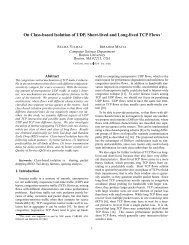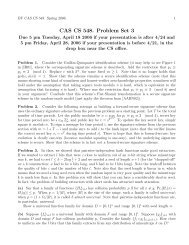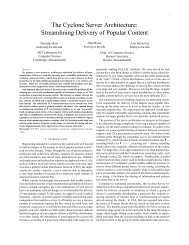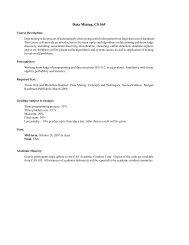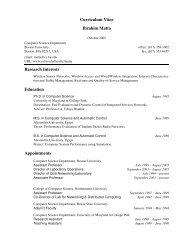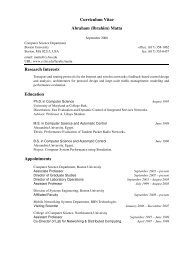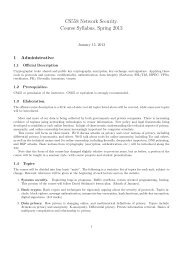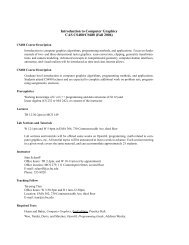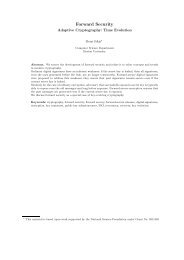uniform test of algorithmic randomness over a general ... - CiteSeerX
uniform test of algorithmic randomness over a general ... - CiteSeerX
uniform test of algorithmic randomness over a general ... - CiteSeerX
Create successful ePaper yourself
Turn your PDF publications into a flip-book with our unique Google optimized e-Paper software.
36 PETER GÁCS<br />
C.2.1. Definitions. Section A gives a review <strong>of</strong> topological concepts. A constructive topological<br />
space X = (X, σ, ν) is a topological space <strong>over</strong> a set X with a subbase σ effectively<br />
given as a list σ = {ν(1), ν(2), . . . }, and having the T 0 property (thus, every point is determined<br />
uniquely by the subset <strong>of</strong> elements <strong>of</strong> σ containing it). By definition, a constructive<br />
topological space satisfies the second countability axiom. 3 We obtain a base<br />
σ ∩<br />
<strong>of</strong> the space X by taking all possible finite intersections <strong>of</strong> elements <strong>of</strong> σ. It is easy to<br />
produce an effective enumeration for σ ∩ from ν. We will denote this enumeration by ν ∩ .<br />
The product operation is defined <strong>over</strong> constructive topological spaces in the natural way.<br />
Examples C.1.<br />
1. A discrete topological space, where the underlying set is finite or countably infinite, with<br />
a fixed enumeration.<br />
2. The real line, choosing the base to be the open intervals with rational endpoints with<br />
their natural enumeration. Product spaces can be formed to give the Euclidean plane a<br />
constructive topology.<br />
3. The real line R, with the subbase σ<br />
R > defined as the set <strong>of</strong> all open intervals (−∞; b) with<br />
rational endpoints b. The subbase σ<br />
R < , defined similarly, leads to another topology. These<br />
two topologies differ from each other and from the usual one on the real line, and they<br />
are not Hausdorff spaces.<br />
4. Let X be a set with a constructive discrete topology, and X ω the set <strong>of</strong> infinite sequences<br />
with elements from X, with the product topology: a natural enumerated basis is also<br />
easy to define.<br />
Due to the T 0 property, every point in our space is determined uniquely by the set <strong>of</strong> open<br />
sets containing it. Thus, there is a representation γ X <strong>of</strong> X defined as follows. We say that<br />
γ X (p) = x if En Σ (p) = { w : x ∈ ν(w) }. If γ X (p) = x then we say that the infinite sequence<br />
p is a complete name <strong>of</strong> x: it encodes all names <strong>of</strong> all subbase elements containing x. From<br />
now on, we will call γ X the complete standard representation <strong>of</strong> the space X. 4<br />
C.2.2. Constructive open sets, computable functions. In a constructive topological space<br />
X = (X, σ, ν), a set G ⊆ X is called r.e. open in set B if there is a r.e. set E with<br />
G = ⋃ w∈E ν∩ (w) ∩ B. It is r.e. open if it is r.e. open in X. In the special kind <strong>of</strong> spaces<br />
in which <strong>randomness</strong> has been developed until now, constructive open sets have a nice<br />
characterization:<br />
Proposition C.2. Assume that the space X = (X, σ, ν) has the form Y 1 × · · · × Y n where<br />
each Y i is either Σ ∗ or Σ ω . Then a set G is r.e. open iff it is open and the set { (w 1 , . . . , w n ) :<br />
⋂<br />
i ν(w i) ⊂ G } is recursively enumerable.<br />
Pro<strong>of</strong>. The pro<strong>of</strong> is not difficult, but it relies on the discrete nature <strong>of</strong> the space Σ ∗ and on<br />
the fact that the space Σ ω is compact and its base consists <strong>of</strong> sets that are open and closed<br />
at the same time.<br />
□<br />
3 A constructive topological space is an effective topological space as defined in [24], but, for simplicity we<br />
require the notation ν to be a total function.<br />
4 The book [24] denotes γX as δ X ′ instead. We use γ X only, dispensing with the notion <strong>of</strong> a “computable”<br />
topological space.<br />
♦





